ORP-HPT03B Full Translucent Stretcher for Patient Transport
A stretcher for patient transport is a crucial piece of medical equipment designed to safely and efficiently move patients within or between healthcare facilities. Typically constructed from lightweight but durable materials such as aluminum, stretchers are equipped with various features to enhance patient safety, comfort, and ease of handling. These include adjustable backrests to accommodate different medical conditions, thick padded mattresses to prevent pressure sores, and hydraulic systems for adjusting height and tilt. Additionally, stretchers are outfitted with locking wheels to secure the stretcher during procedures or when stationary, and bumper wheels to protect against impacts during movement. For enhanced maneuverability in tight spaces and emergency situations, they often come with features like an emergency push handle and a directional wheel system. IV poles and hooks are integrated to facilitate the administration of fluids and medications during transport.
Technical Parameter:
| Bed Height Min | 590mm |
| Bed Height Max | 910mm |
| Platform Size | 1940*620mm |
| Overall Size | 2150*810mm |
| Mattress Thickness | 50mm |
| Safe Working Load | 250kg |
| Back-rest | 75°±5° |
| Knee-rest | 30°±5° |
| Trendelenburg | 15°±5° |
| Reverse Trendelenburg | 15°±5° |
Technical Configuration:
| Hydraulic Pump | 2pcs |
| Hand Crank | 2pcs |
| Back Rest Gas Spring | 1pc |
| 8’’ Caster | 4pcs |
| Central Locking Pedal | 2pcs |
| Directional Wheel Release Pedal | 2pcs |
| Function Control Pedal | 1set |
| Emergency Push Handle | 1set |
| Directional wheel | 1pc |
| Foldable Side Rail | 1set |
| IV Pole | 1set |
| IV Pole Prevision | 6pcs |
| Bumper Wheel | 4pcs |
Product Introduction:
Quality Control:
- Technology: The technology behind stretcher for patient transport has significantly evolved to enhance their durability, safety, and ease of use. These stretchers are constructed from cold-rolled steel sheets, a material choice that provides a strong yet lightweight frame crucial for the efficient maneuverability required in medical emergencies. Cold-rolled steel is favored for its fine surface finish and structural integrity. To protect these stretchers from wear and environmental factors, they undergo advanced finishing processes including electrophoretic coating and powder coating. Electrophoretic coating involves the application of a paint emulsion through an electrical current, which leads to a uniform and corrosion-resistant layer. This is followed by a powder coating, where a dry powder is applied and then cured under heat to form a tough, protective outer skin. This combination of coatings not only extends the stretcher’s lifespan by preventing rust and degradation but also ensures it remains hygienic and easy to clean, a crucial factor in medical settings. Together, these technologies contribute to reliable and robust stretchers that are essential for safe and effective patient transport.
- Safety Standard: Stretchers for patient transport are required to meet rigorous safety standards to ensure they are reliable and secure for both patients and medical personnel. These stretchers are certified under ISO 13485:2016, focusing on quality management systems specifically designed for the manufacturing of medical devices, ensuring that every aspect from design to production meets stringent medical standards. Additionally, they comply with ISO 9001:2015, which covers general quality management systems, emphasizing consistency and customer satisfaction. Furthermore, stretchers for patient transport also carry CE certification, indicating compliance with European Union safety, health, and environmental protection standards. This certification is crucial for use within EU countries and is recognized globally as a mark of high safety and quality. These certifications collectively ensure that stretchers for patient transport are manufactured to the highest standards, enhancing patient safety during transport.
Framework:
- Platform: The platform of a stretcher for patient transport is ingeniously segmented into four key sections: the backboard, the seat section, the thigh board, and the calf board. This segmentation enhances the functionality and adaptability of the stretcher, catering specifically to various medical and emergency needs. One of the standout features of this stretcher platform is its construction from materials that are transparent to X-rays. This design choice facilitates comprehensive X-ray examinations without the need to move the patient, thereby reducing discomfort and potential risk during critical care situations. Additionally, the stretcher includes a mechanism controlled by a hand crank located on the side. This hand crank allows for the precise positioning of an X-ray cassette holder beneath the platform, enabling full-body imaging. This feature is particularly valuable in emergency and clinical settings, where quick and thorough diagnostic assessments are crucial. Overall, the stretcher’s platform is a testament to advanced medical engineering, combining patient comfort, safety, and diagnostic compatibility.
- Foldable Side Rail: The side rails of a stretcher for patient transport are meticulously designed with both safety and functionality in mind. Constructed from durable stainless steel, these side rails are foldable, allowing for easy adjustments based on the needs of patient care and transport. To enhance safety, they incorporate anti-trapping features that prevent the rails from accidentally closing, ensuring patient protection during movement. Furthermore, each rail is equipped with a secure locking mechanism, which effectively prevents the rails from unintentionally folding down. This is particularly important in preventing patient falls or other accidents during transport. To facilitate patient transfers or medical procedures, the rails can be quickly and easily folded down by lifting the locking mechanism, providing healthcare workers unobstructed access to the patient while maintaining the integrity and safety of the stretcher. This combination of robust materials, safety features, and functional design makes these side rails an integral part of the stretcher’s overall efficacy in patient transport.
- Base: The base of the stretcher for patient transport is thoughtfully designed to enhance both functionality and durability in high-stress medical environments. It features a dust cover made from polypropylene (PP) material, known for its strength, durability, and high-temperature resistance, making it ideal for the demanding conditions of medical use. This material choice ensures that the base remains clean and free from contaminants, which is crucial in a healthcare setting. Additionally, the base is equipped with specially designed slots that serve as storage spaces for essential emergency equipment such as oxygen cylinders and other medical supplies. This integrated storage capability not only maximizes the use of space but also ensures that lifesaving tools are easily accessible during transport. Such practical and robust design elements make the stretcher more efficient and reliable for emergency response teams, aiding them in providing prompt and effective patient care.
Function:
The following functions are controlled by the FOOT PEDAL:
- Trendelenburg/Reverse Trendelenburg: The stretcher for patient transport is equipped with advanced positioning capabilities, specifically the Trendelenburg and Reverse Trendelenburg functions, which are critical for managing patient care during transport. These features allow the stretcher to tilt backward in the Trendelenburg position and forward in the Reverse Trendelenburg position, each adjustable to an angle of 15°±5°. This range of tilt provides versatility in patient positioning, which can be essential for various medical conditions. For instance, the Trendelenburg position helps enhance venous return in hypotensive patients or can be used in certain emergency conditions to improve circulation. Conversely, the Reverse Trendelenburg position is beneficial for patients with respiratory issues, as it elevates the head and upper body, aiding in easier breathing and better lung expansion. The ability to swiftly and accurately adjust the stretcher to these positions ensures that caregivers can promptly respond to changing patient needs, enhancing the effectiveness of care and potentially improving patient outcomes during transport.
- Whole Stretcher Height Adjustment: The stretcher for patient transport features a highly adaptable height adjustment mechanism, designed to enhance both patient comfort and caregiver ergonomics. This mechanism allows the stretcher’s height to be varied from 590mm to 910mm, providing a substantial range that can be precisely tailored to meet the requirements of different medical situations and user heights. Such versatility is crucial during patient transfers, particularly when aligning the stretcher with other medical equipment like hospital beds or surgical tables, thereby facilitating smoother and safer patient handling. The adjustable height not only aids in reducing the physical strain on healthcare workers as they perform transfers and procedures but also improves the overall safety and comfort for the patient. This feature ensures that the stretcher can be optimally positioned for both emergency and routine patient care, making it an indispensable tool in medical transport scenarios.
The following function is controlled by the HAND CRANK:
- Leg Section Adjustment: The stretcher for patient transport includes a manually adjustable leg section, enhancing the comfort and therapeutic needs of patients during transport. This feature allows for an adjustment range of 30°±5°, providing essential flexibility to elevate the legs, which can be crucial for various medical conditions. Elevating the leg section can help improve circulation, reduce swelling, and alleviate discomfort for patients, particularly during lengthy transports or when certain medical interventions are required. The manual adjustment mechanism is designed for ease of use, ensuring that healthcare providers can quickly and efficiently set the leg section to the desired angle without the need for electrical power. This not only simplifies the operation but also increases the reliability of the stretcher under different circumstances. Such adaptability in leg positioning is vital for optimizing patient care and comfort, making the stretcher a versatile and practical choice in diverse medical settings.
The following function is controlled by the HANDLE:
- Back Section Adjustment: The stretcher for patient transport is equipped with an adjustable back section that significantly enhances patient comfort and facilitates various medical procedures. The adjustment mechanism is operated manually by pressing a handle located under the back panel, allowing caregivers to easily lift the back section to the desired position. The backrest can be adjusted up to an angle of 75°±5°, providing a wide range of positions that can support different patient needs, such as respiratory ease, comfort during feeding, or when certain diagnostic procedures require an upright posture. This feature is particularly beneficial in emergency and routine medical settings where quick adjustments are necessary. By enabling precise control over the back section’s angle, the stretcher ensures that patients can be quickly and comfortably positioned while maintaining stability and safety throughout the transport or procedure.
Accessory Detail:
- Hydraulic Pump: The stretcher for patient transport is equipped with an advanced hydraulic pump system, which includes two hydraulic pumps that control the height and the tilt (both forward and reverse) of the stretcher. This dual-pump configuration allows for more precise, smooth, and quiet adjustments, significantly enhancing the overall functionality and usability of the stretcher. The precision offered by the hydraulic system ensures that height adjustments and tilting can be executed with minimal effort and maximum control, which is crucial in sensitive medical environments where patient stability and comfort are paramount. Additionally, the smooth operation facilitated by the hydraulic pumps minimizes disruptions, making it easier to perform procedures or transport patients without causing discomfort. The quiet nature of the hydraulic system also contributes to a more calming environment, which can be beneficial for patient well-being during transport and treatment. This combination of precision, smooth operation, and quietness makes the hydraulic system an integral part of the stretcher’s design, ensuring optimal performance in various clinical scenarios.
- Caster: The stretcher for patient transport is equipped with four robust 200mm casters, which are designed to enhance mobility and ease of handling across various environments. The larger diameter of these casters significantly reduces the effort required to push the stretcher, even when navigating over obstacles or uneven surfaces. This feature is particularly beneficial in emergency situations where speed and maneuverability are critical, both indoors and outdoors. The casters are made from Thermoplastic Elastomer (TPE) material, which is known for its excellent heat resistance and corrosion-resistant properties. These characteristics ensure that the casters can withstand extreme conditions without degrading, thus maintaining their functionality and extending the life of the stretcher. The combination of large size, material strength, and smooth rolling capability makes these casters ideal for facilitating the quick, stable, and efficient transport of patients under a variety of circumstances.
- Central Locking Pedal: The stretcher for patient transport is equipped with a highly efficient central locking pedal system, designed to provide optimal control and safety during the movement of the stretcher. Positioned conveniently at both the head and the foot ends, these central locking pedals allow for an integrated braking mechanism that controls all the casters simultaneously. By stepping on the red side of the pedal, the operator can engage the brakes, effectively locking all wheels and stabilizing the stretcher in place. This is crucial for ensuring the stretcher remains stationary during critical medical procedures or when the patient needs to be securely positioned. Conversely, pressing the green side of the pedal releases the brakes, allowing the stretcher to move freely. This system not only enhances safety by preventing unwanted movement but also offers the flexibility needed to quickly and efficiently transport the patient across different environments. The intuitive design of the red and green pedals simplifies operation, making it easy for healthcare providers to quickly adapt to the needs of the situation without distraction.
- Directional Wheel with Control Pedal:The stretcher for patient transport incorporates an advanced directional wheel system, which includes a pivotal fifth steering wheel to enhance maneuverability and control. This system is specifically designed to optimize the stretcher’s movement through different environments, particularly in emergency situations. The functionality of the directional wheel is controlled by two pedals, color-coded for ease of use. Pressing the red side of the pedal activates a locking mechanism on this fifth wheel, restricting the stretcher to move only in a straight line. This feature is particularly beneficial during emergencies when rapid and direct transport is necessary, as it allows for swift, stable, and controlled progression through corridors and around obstacles without deviation. When the green side of the pedal is pressed, it unlocks the fifth wheel, giving the stretcher the ability to move freely in any direction. This versatility is crucial in crowded or complex spaces where precise, multi-directional movement is required. The inclusion of this directional wheel system significantly enhances the stretcher’s functionality, providing quick response capabilities while maintaining safety and stability.
- IV Pole&IV Pole Prevision: The stretcher for patient transport is thoughtfully equipped with an adjustable IV pole, crafted from durable stainless steel, ensuring longevity and resistance to corrosion. This IV pole features four hooks, allowing multiple IV bags to be hung simultaneously, accommodating the critical needs of patients who require various infusions during transport. To further enhance its utility, the stretcher includes six IV pole provisions strategically positioned around the edges of the bed. This placement ensures that the IV pole can be inserted at multiple points along the stretcher, providing flexibility in positioning the IV lines according to the patient’s needs and the medical staff’s requirements. Whether the patient is being moved within the hospital or needs to be positioned in a specific way, the adjustable height and multiple insertion points of the IV pole system simplify the process of managing intravenous therapies, making it versatile and highly functional for diverse medical scenarios.
- Emergency Push Handle: The stretcher for patient transport is equipped with an emergency push handle, specifically designed to enhance maneuverability and control during urgent situations. This handle facilitates the exertion of additional force when pushing the stretcher, enabling healthcare providers to quickly and efficiently navigate through hospital corridors and other environments during emergencies. Recognizing the importance of space optimization in medical settings, the emergency push handle features a foldable design. This allows the handle to be collapsed when not in use, thereby conserving valuable space and maintaining a streamlined profile for the stretcher. This design not only ensures readiness for rapid response situations but also contributes to the overall practicality and functionality of the stretcher, making it an indispensable tool in emergency medical care.
- Mattress: The mattress on the stretcher for patient transport is designed with both comfort and practicality in mind, featuring a 50mm thick soft sponge core that provides essential support and cushioning for patients during transport. This core helps distribute weight evenly, reducing pressure points and significantly lowering the risk of developing pressure ulcers, a common concern for patients who are immobile for extended periods. Encasing the sponge core is a waterproof and breathable cover, which not only protects the mattress from spills and contaminants but also promotes air circulation. This combination of waterproofing and breathability is crucial in maintaining hygiene and comfort, as it prevents moisture buildup that can lead to skin irritation and enhances the overall patient experience. The thoughtful design of this mattress ensures that it meets the rigorous demands of medical transport, offering durability, hygiene, and patient comfort in a single solution.
- Bumper Wheel: The stretcher for patient transport is equipped with bumper wheels located at each of the four corners, crafted from a soft, impact-absorbing material. These bumpers play a critical role in enhancing the safety and durability of the stretcher by mitigating the forces generated during collisions. When the stretcher inadvertently comes into contact with walls, doorways, or other obstacles, these bumper wheels absorb and dissipate the impact energy, thereby protecting not only the stretcher itself from damage but also safeguarding the surrounding infrastructure. More importantly, the presence of these bumpers minimizes the shock transmitted to the patient, thereby preventing additional discomfort or injury. This feature is essential in maintaining a secure environment for both the patient and healthcare providers, reducing potential costs from damages and increasing overall safety during patient transport. The strategic placement and material choice of these bumper wheels underscore their importance in promoting a safer and more reliable patient handling experience.
PUSH HANDLE
Both stretcher head and foot equipped with a set of handle, for pushing in emergency situation.
CASTER
Four 200mm casters, the larger the diameter of the casters, the less effort to push, the better the ability to overcome obstacles, suitable for rapid implementation in emergency situations in different indoor and outdoor environments. TPE material, heat resistance, corrosion resistance.
PLATFORM
Include four parts: back plate, buttock plate, thigh plate and calf plate. The whole platform is made of X-ray fluoroscopic materials, which makes it easy to X-ray patients without moving them. The motion of the X-ray box below is controlled by the hand rocker on the side for full-body shooting.
CENTRAL LOCKING PEDAL
The head and tail of the stretcher have a central control brake pedal, which can brake as a whole and control all the casters. Put on the red side and apply the brakes. Step on the green side, the stretcher can move.
FOOT PEDAL
From left to right: overall rise, backward tilt, overall fall, forward tilt, the fifth guide wheel landing, the fifth guide wheel lifting.
SIDE RAIL LOCKING SYSTEM
Stainless steel, foldable. With anti-card design, enhance security. With a buckle device, can effectively prevent the guardrail accidental folding. The lifting clip device can fold the guardrail, which is convenient for patient transfer and treatment.




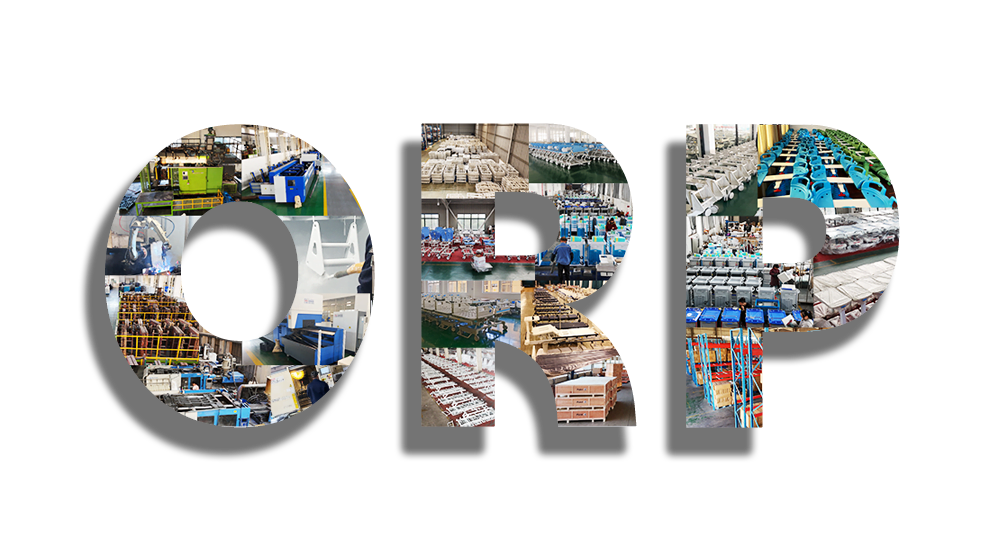






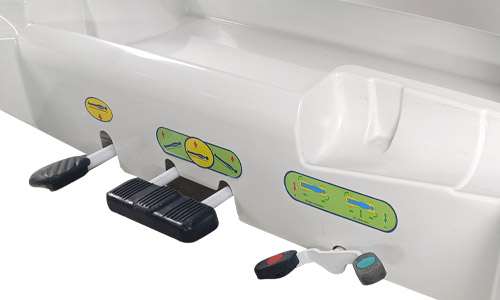
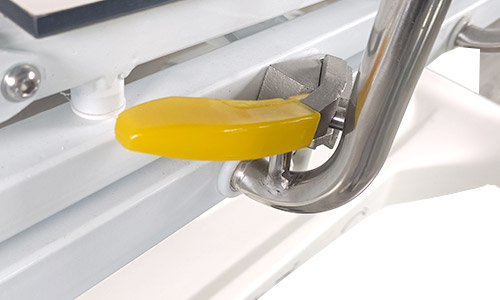
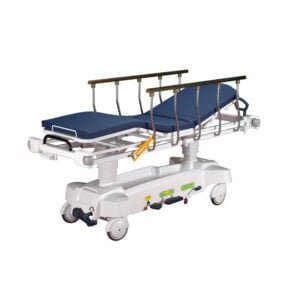

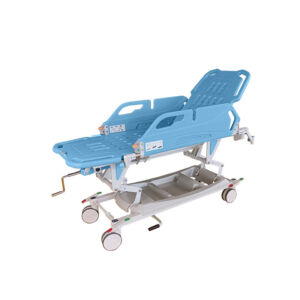
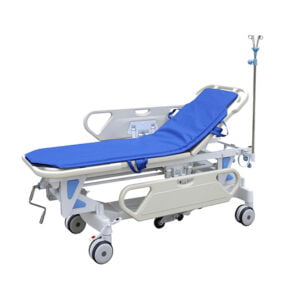

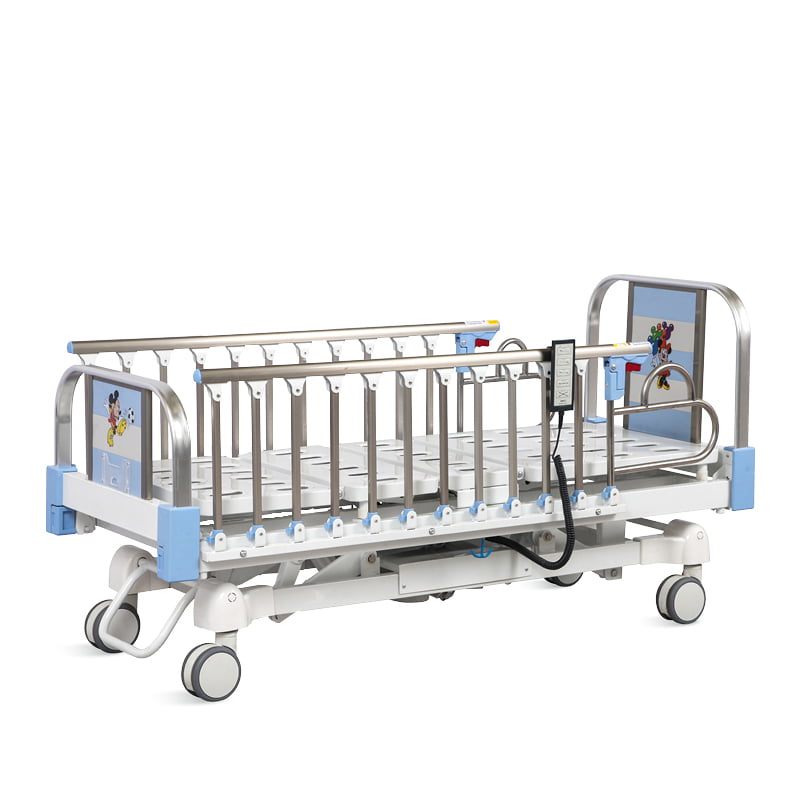
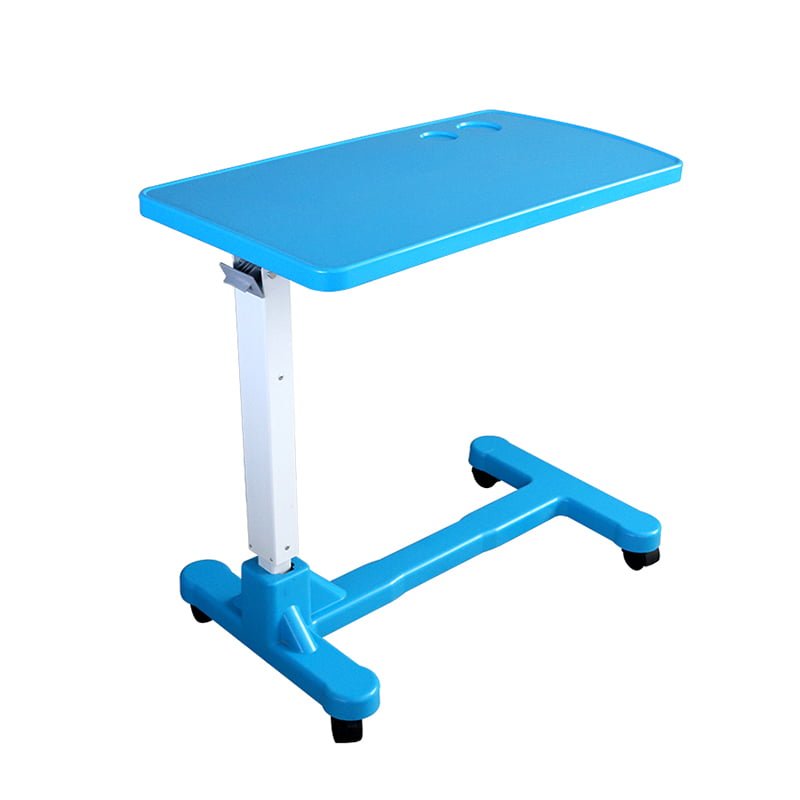
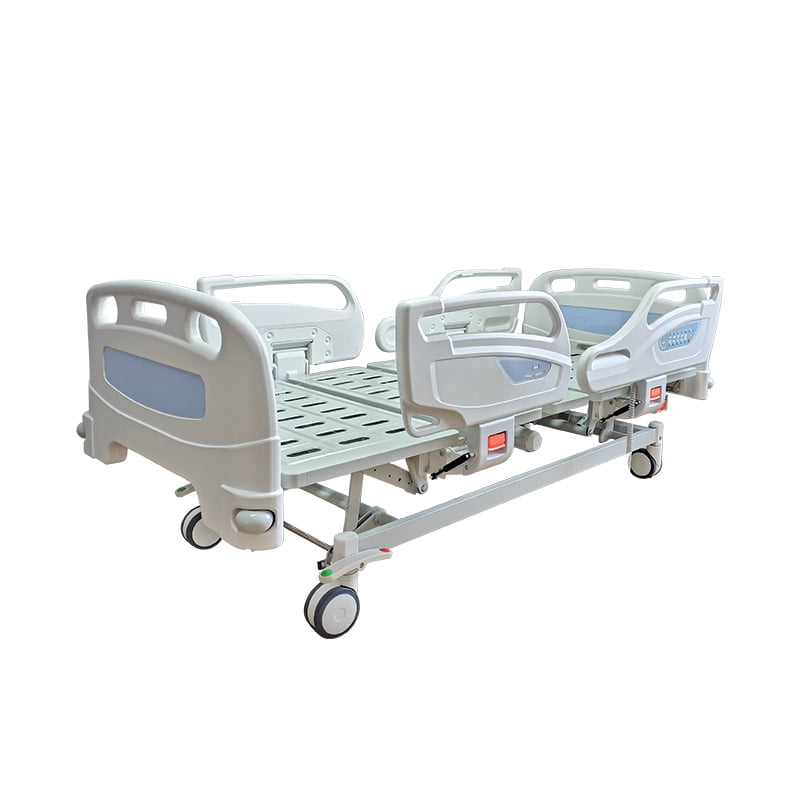
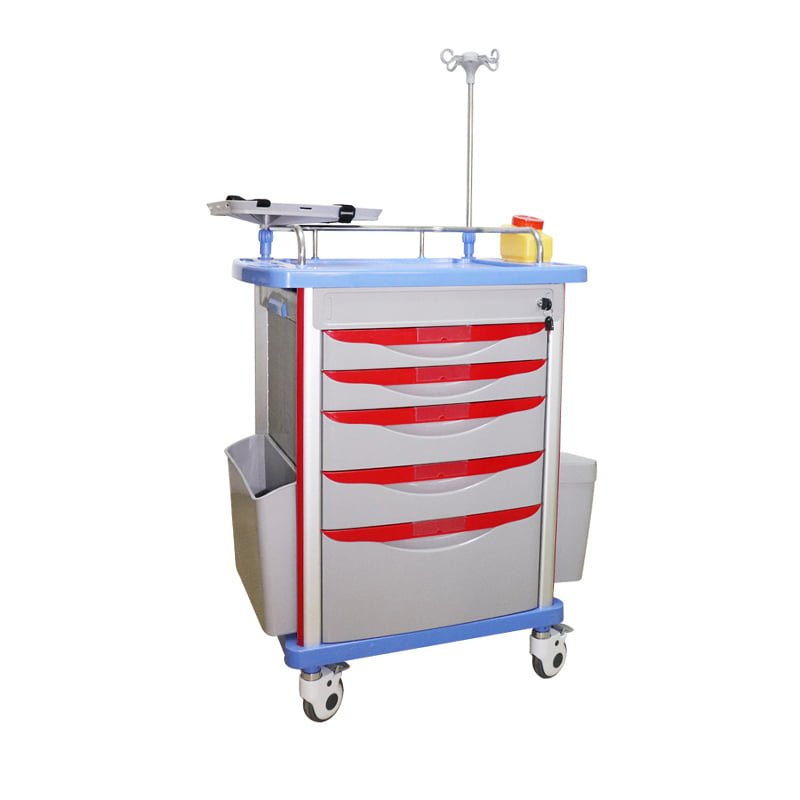
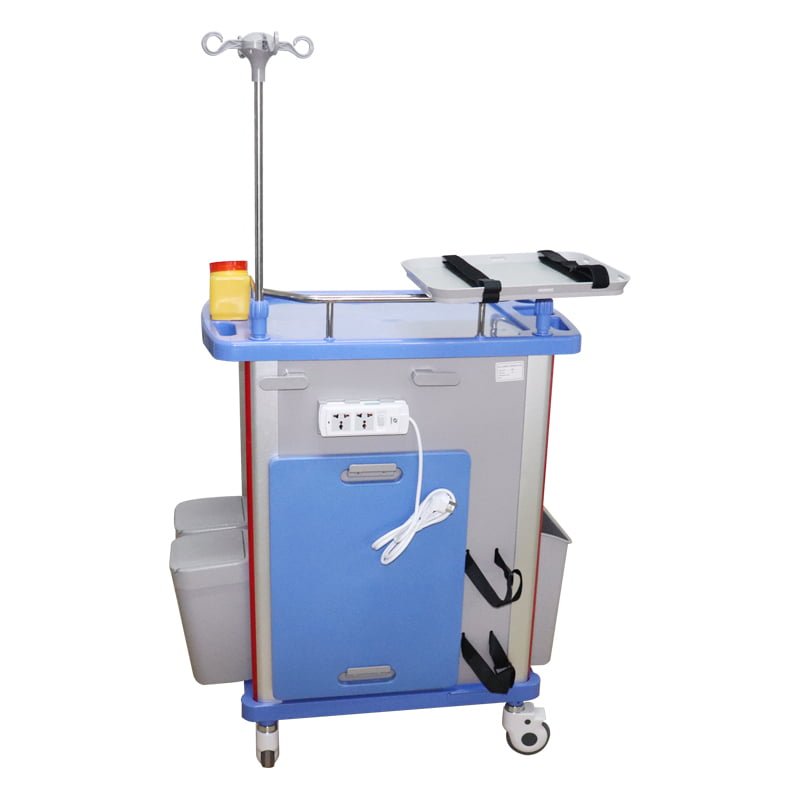
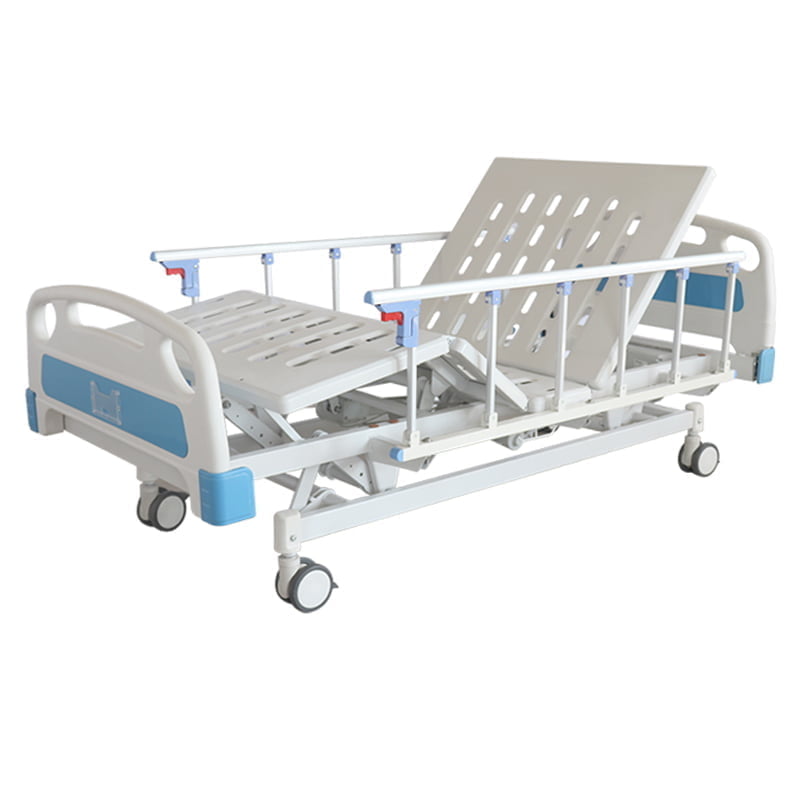
Reviews
There are no reviews yet.